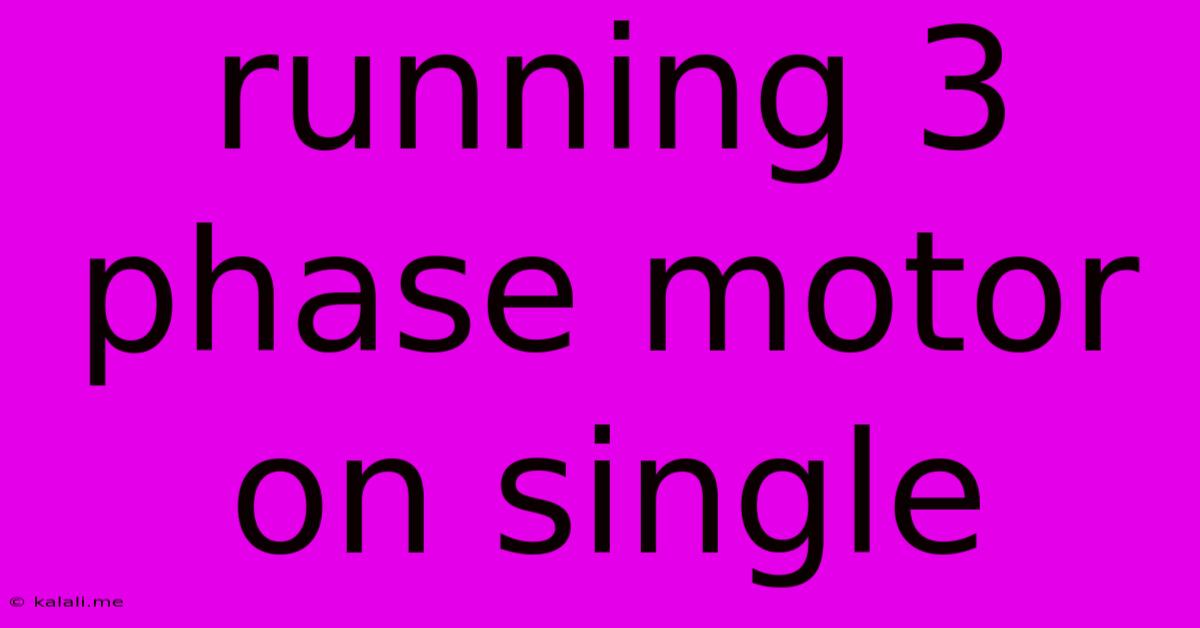Running 3 Phase Motor On Single
Kalali
May 29, 2025 · 4 min read

Table of Contents
Running a 3-Phase Motor on Single Phase: A Comprehensive Guide
Meta Description: Learn how to successfully run a 3-phase AC motor on a single-phase power supply. This guide explores various methods, their pros and cons, and crucial safety considerations. Discover the best approach for your specific needs and equipment.
Running a three-phase AC motor on a single-phase power supply might seem impossible, but it's achievable using several methods. This is particularly useful in situations where three-phase power isn't readily available, such as in homes or remote locations. However, it's crucial to understand the limitations and potential drawbacks before attempting this conversion. This comprehensive guide will walk you through the different approaches, their advantages and disadvantages, and essential safety precautions.
Understanding the Challenge
Three-phase motors rely on a rotating magnetic field created by the three phases of power to generate torque and spin the rotor. A single-phase supply lacks this rotating field, resulting in a motor that won't start or run efficiently on its own. The methods described below aim to artificially create a rotating field using the available single-phase power.
Methods for Running a 3-Phase Motor on Single Phase
Several methods exist to power a three-phase motor from a single-phase source. Each has its own set of benefits and drawbacks:
1. Phase Converters:
- How it works: Phase converters use capacitors or other electronic components to create two additional artificial phases from a single-phase input, mimicking a three-phase system. They come in static (capacitor-based) and rotary (motor-generator) types.
- Pros: Relatively simple to install for smaller motors. Static converters are generally more affordable.
- Cons: Capacitor-based converters can be inefficient and may not be suitable for high-power motors. Rotary converters are more efficient but are bulkier, noisier, and more expensive. They also introduce additional moving parts that require maintenance.
- Suitable for: Smaller motors, applications where efficiency isn't critical.
2. Single-Phase to Three-Phase Motor Starters:
- How it works: These specialized starters use capacitors and other circuitry to create a rotating magnetic field sufficient for starting the motor. They often incorporate techniques to adjust the starting and running currents efficiently.
- Pros: Can provide better starting torque compared to simple capacitor methods. Relatively compact for their power handling capabilities.
- Cons: More expensive than simple capacitor-based methods. Requires careful selection based on motor specifications.
- Suitable for: Applications requiring improved starting torque and moderate power requirements.
3. VFD (Variable Frequency Drive):
- How it works: A VFD is a sophisticated electronic device that converts single-phase AC power into three-phase AC power at a variable frequency. This allows for precise control over the motor's speed and torque.
- Pros: Highly efficient, provides excellent speed control, and allows for soft starting to protect the motor and reduce wear and tear.
- Cons: Most expensive option. Requires more technical expertise for setup and configuration.
- Suitable for: High-power applications, precise speed control, and situations where efficiency is paramount.
4. Running the Motor Directly (with limitations):
This is the simplest approach but highly inadvisable for most applications. Connecting the motor directly to a single phase will only allow the motor to run in a very inefficient manner if it runs at all. It will likely severely overheat and damage the windings. It may also require a high initial current that will overload the system.
Safety Precautions
Regardless of the method chosen, safety is paramount:
- Proper Wiring: Always ensure correct wiring to avoid short circuits and electrical hazards.
- Overload Protection: Use appropriate overload relays or circuit breakers to protect both the motor and the power supply.
- Grounding: Proper grounding is essential to prevent electrical shocks.
- Ventilation: Adequate ventilation is crucial to prevent overheating, especially when using less efficient methods.
- Professional Assistance: If you lack experience working with electrical systems, seek professional assistance.
Choosing the Right Method
The best method for running a three-phase motor on single phase depends on several factors, including the motor's power rating, the required efficiency, the need for speed control, and the available budget. For smaller motors with less demanding requirements, a capacitor-based phase converter might suffice. However, for larger motors or applications requiring precise speed control and high efficiency, a VFD is the preferred choice. Remember to always prioritize safety and consult with qualified electricians if needed.
Latest Posts
Latest Posts
-
Dnd How Far Can You Throw Weapon
May 30, 2025
-
Make Your Own Cards Against Humanity
May 30, 2025
-
How Can You Tell If An Outlet Is Grounded
May 30, 2025
-
How Tall Is The Emperor Of Mankind
May 30, 2025
-
Blender Create Vertex In The Middle Of The Edge
May 30, 2025
Related Post
Thank you for visiting our website which covers about Running 3 Phase Motor On Single . We hope the information provided has been useful to you. Feel free to contact us if you have any questions or need further assistance. See you next time and don't miss to bookmark.